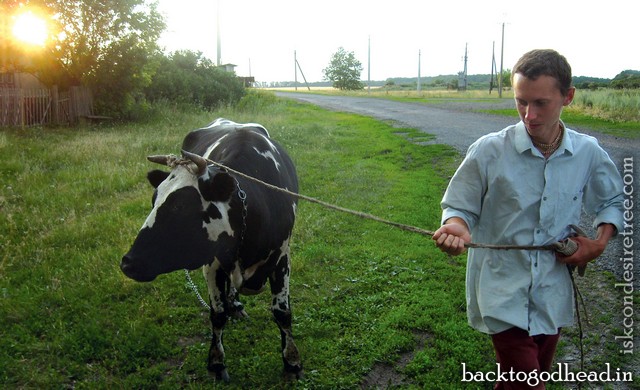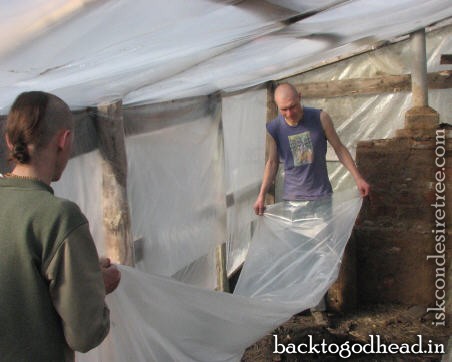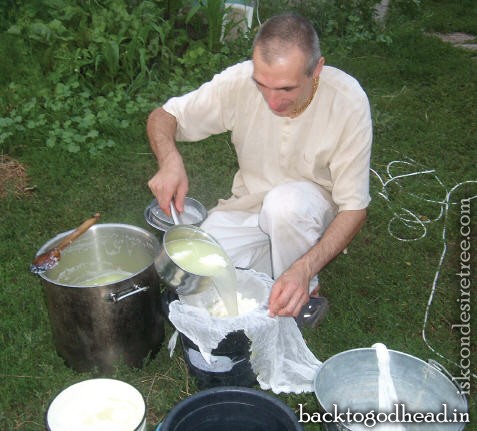People natu raly see everything in terms of the world they are accustomed to. This cultural bias manifests in many ways, such as when the people of so-called prosperous countries set out to measure and fix poverty. Thinking that monetary income determines poverty, they project their conception on the rest of the world. They look at the world in terms of income and find that more than half of humanity is poor. Good souls that they are, they want to fix the problem.

But is the experience of a poor person in a poor country the same as that of a poor person in a rich country? No. As a general observation I’d say that most people in “poor” countries are relatively comfortable while the poor in “rich” countries are not.
I have met Indian villagers who would be classified as poor under United Nations guidelines (making less than $1.25 a day), and I can say from direct experience that these people do not think of themselves as poor or feel the effects of poverty as a person in America would at the same level of income. The same is true of the “poor” people I know in Eastern Europe.
What makes the difference? In a word, culture, which includes values and expectations. A house in an Indian or Ukrainian village is vastly different from one in urban or suburban America or Europe, but people live there just as happily as wealthier people living in luxury houses. The same is true for their daily needs. Villagers in India and Ukraine produce a good deal of their own food. They also have fewer clothing requirements than their Western counterparts, and fewer financial demands for things such as cars, insurance, or frivolous consumer goods because these things are not a necessary part of their culture. Nonetheless the UN wants to change their culture, and that of many other people around the world, in order to raise them above “poverty” by making sure they have more than $2 a day. That seems like a laudable goal, but perhaps we might pause to consider just what having more money is likely to do.
We have an example from recent history. Anthropologist Helena Norberg-Hodge was the first foreigner allowed to make her home in Ladakh, Kashmir. Beginning in the 1970s, she had the privilege of living there six months a year for three decades and came to know, and document, life in the traditional villages before the intrusion of Western culture. The Ladakhis lived in an agrarian subsistence economy. Though not an easy life by Western standards, with evident joy they met their basic physical, social, spiritual, and creative needs within the security of a caring, sharing community. Their happiness did not depend on income or possessions; it was simply experienced as a matter of daily living. Being mutually dependent, the villagers maintained a deep-rooted respect for one another’s fundamental needs. And an acceptance of the natural limitations of the environment kept them free from misplacing values of worth.
At the time when this was observed, the Ladakhis might well have been considered poor by international standards because their income was minimal and most of their needs were met as a product of their own hands. Nonetheless, they were a satisfied and joyful people. But something changed that. Norberg-Hodge explains how it was the tourists who brought poverty to Ladakh:
A Western tourist can spend more money in a day than what a Ladakhi family might in one year. Seeing this, Ladakhis suddenly feel poor. The new comparison creates a gap that never existed before because in traditional Ladakh, people didn’t need money in order to lead rich and fulfilling lives. Ladakhi society was based on mutual aid and cooperation; no one needed money for labor, food, clothing, or shelter . . . In the traditional economy, Ladakhis knew that they had to depend on other people, and that others in turn depend on them. In the new economic system, local interdependence disintegrates along with traditional levels of tolerance. In place of cooperative systems meeting needs, competition and scarcity become determinants for survival. Perhaps the most tragic of all the changes I have observed in Ladakh is the vicious circle in which individual insecurity contributes to a weakening of family and community ties, which in turn further shakes individual self-esteem. Consumerism plays a central role in this whole process, since emotional insecurity generates hunger for material status symbols. The need for recognition and acceptance fuels the drive to acquire possessions that will presumably make you somebody.

. . . It is heartbreaking to see people buying things to be admired, respected and ultimately loved, when in fact the effect is almost always the opposite. . . . [They are] set apart, which furthers the need to be accepted.*
Ironically, it was money that brought poverty to Ladakh. Prior to Westerners’ arriving with a lot of money to spend, Ladakhis didn’t consider themselves povertystricken, although their income was probably less than $1.25 a day. Only by comparing themselves to these foreigners what they possessed and how they lived did the Ladakhis begin to see themselves in a different light, as being in poverty and needing what they didn’t need before: money and whatever it buys. Sadly, they were purchasing alienation and isolation at the same time.
In other places around the world, our cultural bias makes us want to eliminate poverty in the sense that we know it. But like the Lakadhis’ experience, will that simply create poverty where it didn’t exist before? One of the United Nations’ Millennium Development Goals (MDG), the elimination of global poverty, includes these three targets:
1. To halve, between 1990 and 2015, the proportion of people whose income is less than $1/day.
2. To achieve full and productive employment and decent work for all, including women and young people.
3. To halve, between 1990 and 2015, the proportion of people who suffer from hunger.
Although these seem worthwhile targets, they are culturally biased; by determining the approach, they limit the means of attainment. The manner in which the targets are stated presupposes a business-development model of production for a market economy and employment of the people they wish to help. Their efforts are in earnest, and last year, in a vague report, the UN Secretary General said that although “significant progress” had been made, urgent and increased efforts were needed to meet the goals by 2015. Hundreds of millions of dollars are being invested in accomplishing these goals. But if the cultural bias were lifted, these same goals could be accomplished with much less money.
An Alternative that Worked
In the past half-century, nearly every development model has failed to bring Sub-Saharan Africa to a level where it can compete in an international market and at the same time give people needed jobs. But the efforts of one young man have stood all of these international-development concepts on their head. A second-generation devotee of Krishna, Alexander Petroff, twenty-five years of age, went to the war-torn, economically struggling Democratic Republic of Congo with a proposition for the government. He wanted to build a self-sufficient, environmentally sustainable village. The government agreed to his proposal and gave him forty hectares of land on which his organization, Working Villages International (WVI), created a development model called Village Self Reliance. Village Self Reliance is founded on the two ideas of swadeshi and sustainable agriculture. The Gandhian principle swadeshi refers to local production for local consumption people producing for their own needs. According to the principle of swadeshi, whatever is made or produced in the village must be used first and foremost by the members of the village. Any excess can then be sold. With this approach, at the very least people have jobs and are fed. Sustainable agriculture is accomplished by using organic methods without external inputs, and using bullocks for plowing instead of fuel-thirsty tractors.
Starting with $70,000 from private donations, within two years WVI employed 400 workers supporting 350 families and producing 50,000 lbs. of rice per month, becoming the second-largest rice producer in the province. They also grew tons of vegetables. Instead of solving problems at the symptom level, WVI addressed the root causes of hunger, unemployment, and violence using a development model that can be adjusted to almost any region in the world. So in two years, not fifteen, one young man working with local people on a very modest budget accomplished not only the economic targets of the MDG, but many of the other targets as well.
Instead of jumping through a lot of hoops to adjust the income, why not simply adjust the culture by removing the external demandsn This is easier because in many parts of the world a simple culture already exists. We have an uphill battle, however, if we want to change the culture by luring people into being consumers, having jobs, commuting to work each day, and changing their lifestyle to one of artificial dependence on others. In fact, by choosing the latter approach it is likely that although external economic targets may be realized, the people will be less happy and less secure, just as the Ladakhis were after the arrival of Western culture.
Following Prabhupada’s Model
Changing the culture to one of simplicity is the easiest way to achieve security and happiness. That is what ISKCON’s founder-acarya, Srila Prabhupada, encouraged his followers to do. He called it simple living and high thinking live simply in order to sufficiently care for the needs of the body, and reap the benefits of doing so, including saving time to be used in activities of self-realization. Devotees of Krishna all around the world have experienced the satisfaction that comes from devotional service to the Supreme Lord. If our time is properly used in worship of the Lord, then our simple living can also be fulfilling and satisfying.
“But,” we may protest, “we can’t all go backward to a simple village life. It’s not possible!”

Not everyone will, of course, but certainly many can, especially those who never left, and there are a lot of them. And why not, if they can become secure and fulfilled? Having lived in villages in both India and Ukraine, I have found that it’s not so difficult, and there are many enjoyable aspects of village life that are impossible to achieve in cities.
Right now I live in a simple three-room house in a village near Novo Vodolaga, Ukraine, about an hour’s drive outside the city of Kharkov. This is the site of our developing eco-spiritual community, Gitagrad. The houses in this village, built some fifty years ago during Soviet times, are ready-made for simple living. One central wood stove is used for both cooking and heating. There is no running water in the house, meaning no bathroom, and the toilet is outside. We chop wood and carry water the epitome of simple life throughout the world. Why am I, an American formerly accustomed to modern amenities, living in these “primitive” conditionsn Because I want to follow the instructions of my spiritual master, Srila Prabhupada, who wanted his followers to live simply, saving time for Krishna consciousness, and to learn first-hand the challenges and advantages of doing so. Having lived in Ukrainian villages for about a year, I can say that after accepting and adjusting to the simple mode of living, I do not find it taxing or onerous compared to a more modern standard. One of the reasons for living in a village is to become free from the modes of passion (rajo-guna) and ignorance (tamo-guna) that disturb the mind, distracting it from self-realization. If I’ve learned anything from my experience in the village, it is that it is almost entirely free of rajo-guna and tamo-guna. Village life is self-regulating based on the demands of agriculture and the cows. They have their own time to which we must adjust, instead of attempting to adjust external circumstances to us, as we generally do in artificial city life.
Our effort here is to live a simple life of Krishna consciousness, providing for ourselves by the natural economy what is typically purchased. Nature has its own economy, one that is strong and resilient. The cow does not charge for her milk, or go on strike. Mother Earth does not ask anything in exchange for her gifts. Both give freely, out of love, and all they ask in exchange is simple reciprocation and care. If we take care of them and treat them properly, they will continue to give their gifts despite what goes on in man’s world.
This is what I have called Spiritual Economics, as explained in my book of the same title. Spiritual Economics describes the gift economy that the Lord has arranged an economy of loving reciprocation that does not require money, that artificial creation of modern man. Indeed, we are striving to increase our spiritual economy more and more, and when we can come to the point of living completely according to Spiritual Economics, we will have achieved our goals. Ironically, when we arrive there we will have achieved what the UN considers a state of poverty, living on less than $2 a day. But we think that instead of that being a social tragedy, it will be a wonderful success.
Like poverty, the concept of wealth is a cultural consideration. Not all wealth is measured by money. Wealth is actually better measured by personal happiness and fulfillment. We think that the internal, non-tangible experiences of happiness and fulfillment are more worthy goals to attain than an external income of $2 a day, or even $500 a day. When we can live a simple, natural life in Krishna consciousness, we will then have become very wealthy.
Dhanesvara Dasa received an M.S. degree in engineering from the University of Florida in Gainesville, Florida, USA, in 1973 and joined ISKCON in Gainesville the same year. He has been living and teaching Krishna consciousness in Eastern Europe for the past five years. His book Lessons in Spiritual Economics from the Bhagavad-gita: Part 1, Understanding and Solving the Economic Problem is available from his website (www.spiritualecon. com). You can keep up with his adventures in simple living by subscribing to his blog: http://gita grad.blogspot.com.
